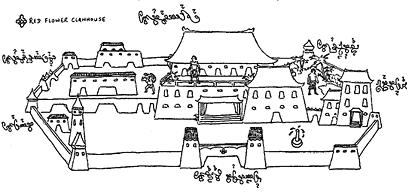The Eye of All-Seeing Wonder
Issue Three | Spring 1994
The Clan of the Red Flower
A closer look at one of the clanhouses in Pala Jakálla
The Red Flower Clan traces its ancestry back to the war-fleets of the ancient kingdom of Vra. Vra was conquered by Tsolyáni troops more than a millenium ago, in the reign of the Emperor Kanmi’yel Nikuma IV, and the fleets were disbanded. In the years that followed, the clan prospered through trade with Ganga, Thayuri and the mainland. Clanhouses were established overseas first at Tleku and Petris Layoda, then at Jakálla and Penom on the coast, then upriver at Pala Jakálla, Bey Sü and Thraya.
The clanhouse in Pala Jakálla has some 800 members (not including children) spread across six lineages:
The Laumek lineage is highest in status. It has seventy members, few of whom take a day-to-day interest in the clan’s shipping business. Some are bureaucrats, others priests and lay-priests of the temples of Thúmis, Hnalla and Ketengku. It is this lineage which holds title to most of the clan’s ships. The family characteristics of the Laumeks are their honesty, dignity and flair—the very models of lan behaviour.
Next in status is the Chaquvar lineage, which has fifty members. This is the traditional provenance of the clan’s navigators and captains. Some other members are enlisted in the Legion of the Echoing Stone and the Squadrons of Tlaneno the Steersman, and a few are guards at the temple of Chegarra. The Chaquvars are noted for their phlegmatic temperament.
The Ji’anash lineage, of medium status, comprises most of the clan’s book-keepers and business administrators. Members are noted for their perspicacity and caustic wit. Some are employed as middle-level bureaucrats at the Palace of Foreign Lands, and a few are scholar-priests at the temple of Wuru. This lineage has eighty members.
The Dorusan lineage has a hundred and ninety members. Many are seamen and bargees, but some younger members enlist as Sakbe guards and city militia for a few years before returning to help with the clan enterprises. The Dorusan lineage are renowned for their bravery and droll wit. Traditionally they are followers of Karakan and Chegarra, but there have been exceptions.
The Issasa lineage traditionally reveres the god Karakan, particularly in his 10th Aspect as Jajkuru the Victor of Ships. From among its two hundred and ninety members are drawn many of the ordinary seamen of the clan. The principal family characteristic is a good-natured willingness to muck in.
The Zinarin lineage is of lowest status. It has a hundred and twenty members, most of whom are engaged in semi skilled labour and activities peripheral to the clan’s business (unloading and transporting of wares, cooking and cleaning, repairs to the clanhouse, care of livestock, etc). Zinarins have a reputation for stubborness.
Assets
The clan’s ocean-going vessels consist of one Tnek (double masted) and three Hru (single-masted). These are capable of transporting cargoes of some nine hundred tonnes, usually on short hauls of a week out to Tleku, Vra or Petris Loyoda. Longer voyages (sometimes as far as Chame’el or Kheiris) are undertaken infrequently.
The clan also has a dozen or so barges for shipping goods by river to Bey Sü and Thraya, and points in between.
Elders
The Pala Jakálla clanhouse is led by a council of twelve elders. Most elders belong to the Laumek and Chaquvar families. Each is appointed for a period of five years, but most have been re-elected to their posts continually for several decades and will continue to serve until removed by senility or death.
The council of elders meets once a week to review domestic affairs, settle intramural disputes and assign funds to clan projects. There is only a general discussion of business, the details of which are left to the Ji’anash family.
The Chief (Dlantü) of the clan is Rifashiya hiLaumek, a sprightly old man of sixty-odd years who cuts quite a dashing figure with his silvery hair and elegant clothes. He gives the impression of never attaching much importance to any difficulties that arise, but manages to deal with things all the same.
Among the other elders, TerShénbei hiDorusan is notable for both his humble origins (he was born in a fishing village on the island of Vra) and his youth. Only twenty-nine, his keen intelligence and calm judgement have made him respected by all.
Noriar hiJi’anash is a gruff old fellow with beetling brows who quietly probes at every aspect of clan life. If there is a feud or a romance going on that everyone else has overlooked, Noriar can be trusted to find out about it.
Gulvesh hiChaquvar is a mild old fellow who is responsible for keeping an eye on the clan buildings. In practice he spends most of his time playing denden over a cup of chumetl while it is left to his assistant, Horu hiZinarin, to make sure that the guttering is kept in good repair and the roof doesn’t leak.

